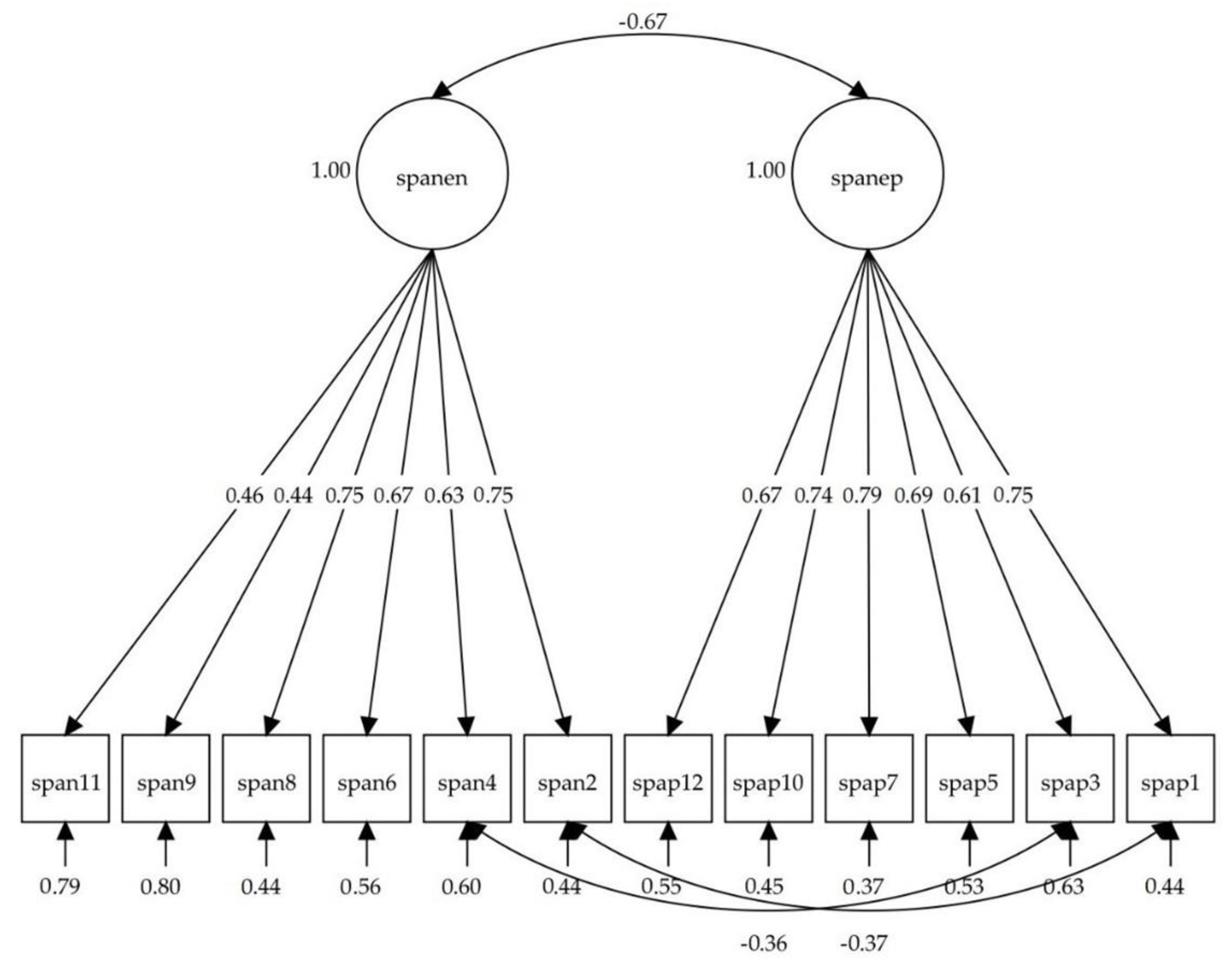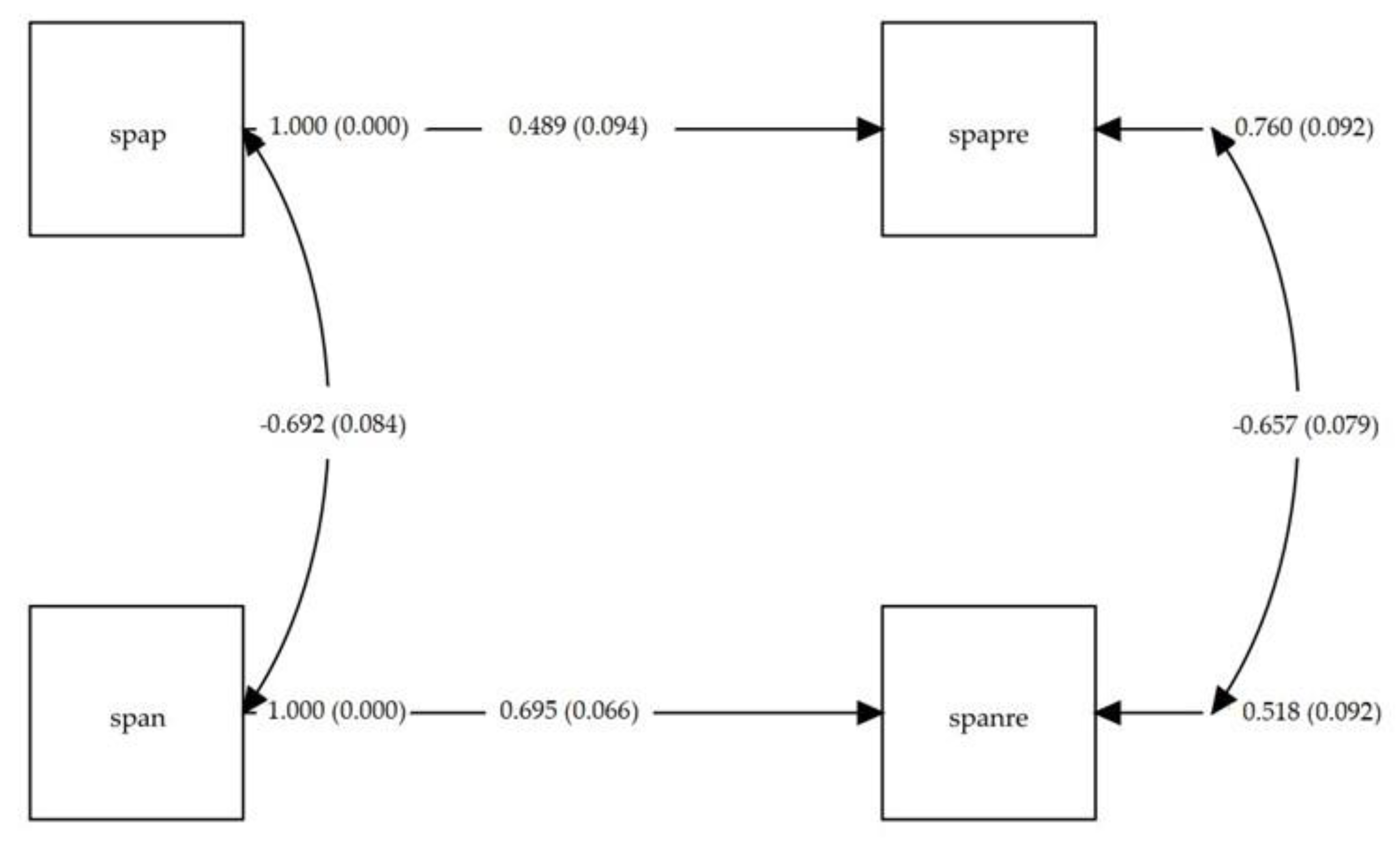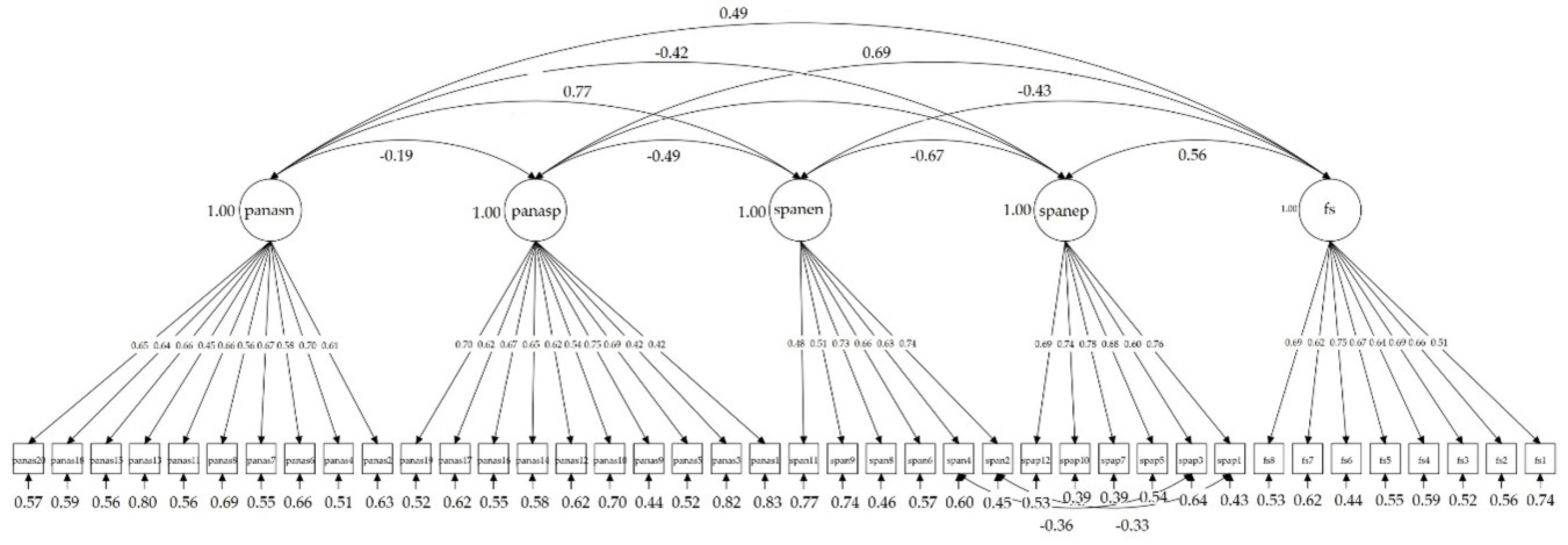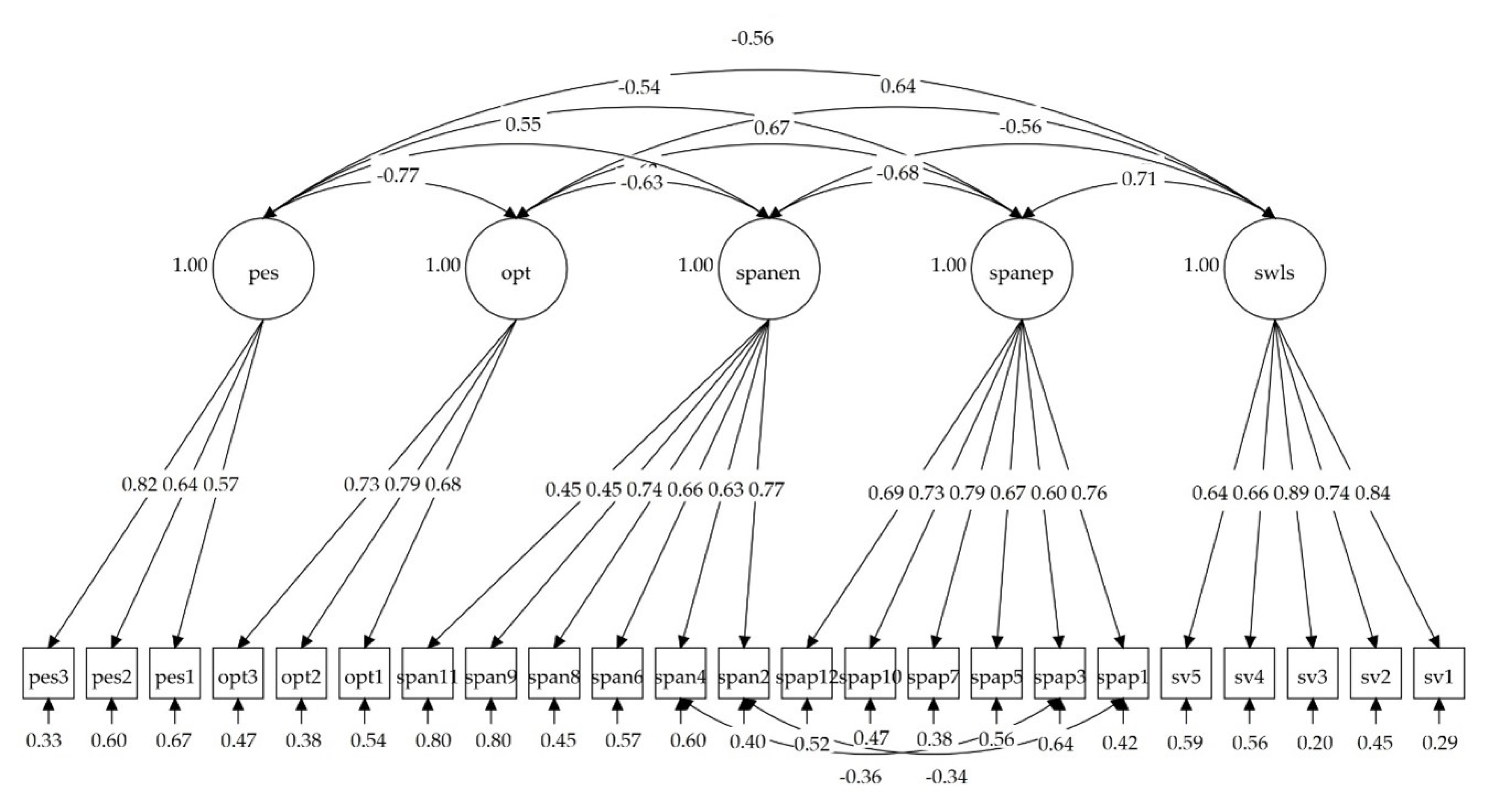Validation and Measurement Invariance of the Scale of Positive and Negative Experience (SPANE) in a Spanish General Sample
Abstract
1. Introduction
2. Materials and Methods
2.1. Participants and Procedure
2.2. Instruments
2.3. Data Analysis
3. Results
3.1. Dimensionality
3.2. Measurement Invariance for Gender
3.3. Test–Retest Reliability and Item-Total Corrected Polyserial Correlations
3.4. Convergent and Concurrent Validity
4. Discussion
5. Conclusions
Author Contributions
Funding
Acknowledgments
Conflicts of Interest
Appendix A
References
- Diener, E. Subjective Well-Being: The Science of Happiness and a Proposal for a National Index. Am. Psychol. 2000, 55, 34–43. [Google Scholar] [CrossRef]
- Ryff, C.D. Happiness is everything, or is it? Explorations on the meaning of psychological well-being. J. Pers. Soc. Psychol. 1989, 57, 1069–1081. [Google Scholar] [CrossRef]
- Seligman, M.E.P.; Csikszentmihalyi, M. Positive Psychology: An Introduction. Am. Psychol. 2000, 55, 5–14. [Google Scholar] [CrossRef]
- Ryan, R.M.; Deci, E.L. On happiness and human potentials: A review of research on hedonic and eudaimonic well-being. Annu. Rev. Psychol. 2001, 52, 141–166. [Google Scholar] [CrossRef]
- Diener, E.D.; Emmons, R.A.; Larsen, R.J.; Griffin, S. The satisfaction with life scale. J. Pers. Assess. 1985, 49, 71–75. [Google Scholar] [CrossRef]
- Watson, D.; Clark, L.A.; Tellegen, A. Development and Validation of Brief Measures of Positive and Negative Affect: The PANAS Scales. J. Pers. Soc. Psychol. 1988, 54, 1063–1070. [Google Scholar] [CrossRef]
- Diener, E.; Wirtz, D.; Tov, W.; Kim-Prieto, C.; Choi, D.; Oishi, S.; Biswas-Diener, R. New Well-being Measures: Short Scales to Assess Flourishing and Positive and Negative Feelings. Soc. Indic. Res. 2010, 97, 143–156. [Google Scholar] [CrossRef]
- Tamir, M.; Schwartz, S.H.; Oishi, S.; Kim, M.Y. The secret to happiness: Feeling good or feeling right? J. Exp. Psychol. Gen. 2017, 146, 1448–1459. [Google Scholar] [CrossRef]
- Schwartz, S.H. Values: Cultural and individual. In Fundamental Questions in Cross-Cultural Psychology; Breugelmans, S.M., Chasiotis, A., van de Vijver, F.J.R., Eds.; Cambridge University Press: New York, NY, USA, 2011; pp. 463–493. ISBN 9780521760157. [Google Scholar]
- Mesquita, B.; de Leersnyder, J.; Albert, D. The cultural regulation of emotions. In Handbook of Emotion Regulation; Gross, J.J., Ed.; Guilford Press: New York, NY, USA, 2014; pp. 284–301. [Google Scholar]
- Bradburn, N.M. The Structure of Psychological Well-Being; Aldine: Oxford, England, 1969. [Google Scholar]
- Diener, E.; Smith, H.; Fujita, F. The personality structure of affect. J. Pers. Soc. Psychol. 1995, 69, 130–141. [Google Scholar] [CrossRef]
- Russell, J.A.; Carroll, J.M. On the bipolarity of positive and negative affect. Psychol. Bull. 1999, 125, 3–30. [Google Scholar] [CrossRef]
- Larsen, R.J.; Diener, E. Affect intensity as an individual difference characteristic: A review. J. Res. Pers. 1987, 21, 1–39. [Google Scholar] [CrossRef]
- Leue, A.; Beauducel, A. The PANAS structure revisited: On the validity of a bifactor model in community and forensic samples. Psychol. Assess. 2011, 23, 215–225. [Google Scholar] [CrossRef]
- Ryan, R.M.; Frederick, C.; Ryff, C.D.; Burns, R.A.; Machin, M.A.; Springer, K.W.; Hauser, R.M.; Raykov, T.; Villar, F.; Triadó, C.; et al. Modern man in search of a soul. Soc. Indic. Res. 2006, 35, 15–28. [Google Scholar] [CrossRef]
- Diener, E.; Sandvik, E.; Pavot, W. Happiness Is the Frequency, Not the Intensity, of Positive versus Negative Affect. In Assessing Well-Being; Diener, E., Ed.; Springer: Dordrecht, The Netherlands, 2009; pp. 213–231. [Google Scholar]
- Padrós-Blázquez, F.; Soriano-Mas, C.; Navarro-Contreras, G. Afecto positivo y negativo: ¿Una dimensión bipolar o dos dimensiones unipolares independientes? Interdiscip. Rev. Psicol. Ciencias Afines 2012, 29, 151–164. [Google Scholar] [CrossRef]
- Scheier, M.F.; Carver, C.S.; Bridges, M.W. Distinguishing Optimism From Neuroticism (and Trait Anxiety, Self-Mastery, and Self-Esteem): A Reevaluation of the Life Orientation Test. J. Pers. Soc. Psychol. 1994, 67, 1063–1078. [Google Scholar] [CrossRef]
- Jovanović, V. Beyond the PANAS: Incremental validity of the Scale of Positive and Negative Experience (SPANE) in relation to well-being. Pers. Individ. Dif. 2015, 86, 487–491. [Google Scholar] [CrossRef]
- Jovanović, V.; Lazić, M.; Gavrilov-Jerković, V.; Molenaar, D. The Scale of Positive and Negative Experience (SPANE): Evaluation of measurement invariance and convergent and discriminant validity. Eur. J. Psychol. Assess. 2019, 36, 694–704. [Google Scholar] [CrossRef]
- Silva, A.J.; Caetano, A. Validation of the flourishing scale and scale of positive and negative experience in Portugal. Soc. Indic. Res. 2013, 110, 469–478. [Google Scholar] [CrossRef]
- Li, F.; Bai, X.; Wang, Y. The Scale of Positive and Negative Experience (SPANE): Psychometric Properties and Normative Data in a Large Chinese Sample. PLoS ONE 2013, 8, e61137. [Google Scholar] [CrossRef]
- Sumi, K. Reliability and Validity of Japanese Versions of the Flourishing Scale and the Scale of Positive and Negative Experience. Soc. Indic. Res. 2014, 118, 601–615. [Google Scholar] [CrossRef]
- Howell, A.J.; Buro, K. Measuring and Predicting Student Well-Being: Further Evidence in Support of the Flourishing Scale and the Scale of Positive and Negative Experiences. Soc. Indic. Res. 2015, 121, 903–915. [Google Scholar] [CrossRef]
- Telef, B.B. The positive and negative experience scale adaptation for Turkish university students. Eur. Sci. J. 2015, 11, 49–59. [Google Scholar]
- Singh, K.; Junnarkar, M.; Jaswal, S. Validating the Flourishing Scale and the Scale of Positive and Negative Experience in India. Ment. Health. Relig. Cult. 2016, 19, 943–954. [Google Scholar] [CrossRef]
- Giuntoli, L.; Ceccarini, F.; Sica, C.; Caudek, C. Validation of the Italian Versions of the Flourishing Scale and of the Scale of Positive and Negative Experience. SAGE Open 2017, 1–12. [Google Scholar] [CrossRef]
- Du Plessis, G.A.; Guse, T. Validation of the Scale of Positive and Negative Experience in a South African student sample. South African J. Psychol. 2017, 47, 184–197. [Google Scholar] [CrossRef]
- Rahm, T.; Heise, E.; Schuldt, M. Measuring the frequency of emotions-validation of the Scale of Positive and Negative Experience (SPANE) in Germany. PLoS ONE 2017, 12, e0171288. [Google Scholar] [CrossRef]
- Cassaretto-Bardales, M.; Martínez-Uribe, P. Validación de las escalas de bienestar, de florecimiento y afectividad. Pensam. Psicol. 2017, 15, 19–31. [Google Scholar] [CrossRef]
- Carmona-Halty, M.; Villegas-Robertson, J.M. Escala de experiencias positivas y negativas (SPANE): Adaptación y validación en un contexto escolar chileno. Interciencia 2018, 43, 317–321. [Google Scholar]
- Kyriazos, T.A.; Stalikas, A.; Prassa, K.; Yotsidi, V. A 3-Faced Construct Validation and a Bifactor Subjective Well-Being Model Using the Scale of Positive and Negative Experience, Greek Version. Psychology 2018, 9, 1143–1175. [Google Scholar] [CrossRef]
- Balgiu, B.A. Validation of the Scale of Positive and Negative Experience (SPANE) on a Romanian student sample. Rev. Psihol. 2019, 65, 209–218. [Google Scholar]
- Daniel-González, L.; de la Rubia, J.M.; Valle de la O, A.; García-Cadena, C.H.; Martínez-Martí, M.L. Validation of the Mexican Spanish Version of the Scale of Positive and Negative Experience in a Sample of Medical and Psychology Students. Psychol. Rep. 2020, 123, 2053–2079. [Google Scholar] [CrossRef] [PubMed]
- Muñiz, J.; Elosúa, P.; Hambleton, R.K. Directrices para la traducción y adaptación de los tests: Segunda edición. Psicothema 2013, 25, 151–157. [Google Scholar] [PubMed]
- Muñiz, J.; Elosúa, P.; Padilla, J.-L.; Hambleton, R.K. Test adaptation standards for cross-lingual assessment. In Educational Measurement. From Foundations to Future; Wells, C.S., Faulkner-Bond, M., Eds.; Guilford Press: New York, NY, USA, 2016; pp. 291–304. [Google Scholar]
- Hernández, A.; Hidalgo, M.D.; Hambleton, R.K.; Gómez-Benito, J. International test commission guidelines for test adaptation: A criterion checklist. Psicothema 2020, 32, 390–398. [Google Scholar] [CrossRef] [PubMed]
- Checa, I.; Perales, J.; Espejo, B. Spanish Validation of the Flourishing Scale in the General Population. Curr. Psychol. 2018, 37, 949–956. [Google Scholar] [CrossRef]
- Ortuño-Sierra, J.; Santarén-Rosell, M.; Pérez-de-Albéniz, A.; Fonseca-Pedrero, E. Dimensional structure of the Spanish version of the Positive and Negative Affect Schedule (PANAS) in adolescents and young adults. Psychol. Assess. 2015, 27, e9. [Google Scholar] [CrossRef]
- Atienza, F.L.; Balaguer, I.; Garcı́a-Merita, M.L. Satisfaction with Life Scale: Analysis of factorial invariance across sexes. Pers. Individ. Dif. 2003, 35, 1255–1260. [Google Scholar] [CrossRef]
- Ferrando, P.J.; Chico, E.; Tous, J.M. Propiedades psicométricas del test de optimismo Life Orientation Test. Psicothema 2002, 14, 673–680. [Google Scholar]
- Greiff, S.; Heene, M. Why Psychological Assessment Needs to Start Worrying About Model Fit. Eur. J. Psychol. Assess. 2017, 33, 313–317. [Google Scholar] [CrossRef]
- Hu, L.; Bentler, P.M. Cutoff criteria for fit indexes in covariance structure analysis: Conventional criteria versus new alternatives. Struct. Equ. Model. 1999, 6, 1–55. [Google Scholar] [CrossRef]
- Marsh, H.W.; Hau, K.-T.; Wen, Z. In Search of Golden Rules: Comment on Hypothesis-Testing Approaches to Setting Cutoff Values for Fit Indexes and Dangers in Overgeneralizing Hu and Bentler’s (1999) Findings. Struct. Equ. Model. 2004, 11, 320–341. [Google Scholar] [CrossRef]
- Raykov, T. Estimation of composite reliability for congeneric measures. Appl. Psychol. Meas. 1997, 21, 173–184. [Google Scholar] [CrossRef]
- Cheung, G.W.; Rensvold, R.B. Evaluating goodness-of-fit indexes for testing measurement invariance. Struct. Equ. Model. 2002, 9, 233–255. [Google Scholar] [CrossRef]
- Muthén, L.K.; Muthén, B. Mplus User’s Guide, 8th ed.; Muthén & Muthén: Los Angeles, CA, USA, 2017. [Google Scholar]
- Jöreskog, K.G. On the estimation of polychoric correlations and their asymptotic covariance matrix. Psychometrika 1994, 59, 381–389. [Google Scholar] [CrossRef]
- Rhemtulla, M.; Brosseau-Liard, P.É.; Savalei, V. When can categorical variables be treated as continuous? A comparison of robust continuous and categorical SEM estimation methods under suboptimal conditions. Psychol. Methods 2012, 17, 354–373. [Google Scholar] [CrossRef] [PubMed]
- Johnson, D.R.; Creech, J.C. Ordinal Measures in Multiple Indicator Models: A Simulation Study of Categorization Error. Am. Sociol. Rev. 1983, 48, 398. [Google Scholar] [CrossRef]
- Raykov, T. Scale construction and development using structural equation modeling. In Handbook of Structural Equation Modeling; Hoyle, R.H., Ed.; The Guilford Press: New York, NY, USA, 2012; pp. 472–492. [Google Scholar]
- Li, C.H. Confirmatory factor analysis with ordinal data: Comparing robust maximum likelihood and diagonally weighted least squares. Behav. Res. Methods 2016, 48, 936–949. [Google Scholar] [CrossRef] [PubMed]
- Raykov, T.; Marcoulides, G.A. Introduction to Psychometric Theory; Routledge Ltd.: New York, NY, USA, 2011; ISBN 0415878225. [Google Scholar]
- IBM. IBM SPSS Statistics for Windows; Version 26.0; IBM: Armonk, NY, USA, 2018. [Google Scholar]
- Brewer, J.F. Graphology. Complement. Ther. Nurs. Midwifery 1999, 5, 6–14. [Google Scholar] [CrossRef]
- Kahneman, D.; Krueger, A.B.; Schkade, D.A.; Schwarz, N.; Stone, A.A. A survey method for characterizing daily life experience: The day reconstruction method. Science 2004, 306, 1776–1780. [Google Scholar] [CrossRef]
- Robinson, M.D.; Clore, G.L. Belief and feeling: Evidence for an accessibility model of emotional self-report. Psychol. Bull. 2002, 128, 934–960. [Google Scholar] [CrossRef]
- De Manincor, M.; Bensoussan, A.; Smith, C.A.; Barr, K.; Schweickle, M.; Donoghoe, L.; Bourchier, S.; Fahey, P. Individualized yoga for reducing depression and anxiety, and improving well-being: A randomized controlled trial. Depress. Anxiety 2016, 33, 816–828. [Google Scholar] [CrossRef]
- Raina, M.; Singh, K. The Ashtanga Yoga Hindi Scale: An assessment tool based on eastern philosophy of Yoga. J. Relig. Health 2018, 57, 12–25. [Google Scholar] [CrossRef] [PubMed]
- Sidorenko, A.; Zaidi, A. Active ageing in CIS countries: Semantics, challenges, and responses. Curr. Gerontol. Geriatr. Res. 2013. [Google Scholar] [CrossRef] [PubMed]
- Feicht, T.; Wittmann, M.; Jose, G.; Mock, A.; von Hirschhausen, E.; Esch, T. Evaluation of a seven-week web-based happiness training to improve psychological well-being, reduce stress, and enhance mindfulness and flourishing: A randomized controlled occupational health study. Evid. Based. Complement. Alternat. Med. 2013. [Google Scholar] [CrossRef] [PubMed]




| χ2 | df | χ2/df | CFI | RMSEA | RMSEA 90% CI | SRMR | |
|---|---|---|---|---|---|---|---|
| (1) 1 factor | 695.205 * | 54 | 3.39 | 0.793 | 0.121 | 0.113, 0.129 | 0.076 |
| (2) 2 factors (P and N) | 648.994 * | 54 | 12.02 | 0.808 | 0.117 | 0.109, 0.125 | 0.198 |
| (3) 2 correlated factors (P and N) | 354.873 * | 53 | 6.53 | 0.902 | 0.084 | 0.076, 0.092 | 0.048 |
| (4) 2 correlated factors (P and N) with correlated errors a | 204.428 * | 51 | 4.01 | 0.950 | 0.061 | 0.052, 0.070 | 0.043 |
| Model | χ2 | df | Δχ2 | Δgl | CFI | RMSEA | RMSEA 90% CI | ΔCFI | ΔRMSEA |
|---|---|---|---|---|---|---|---|---|---|
| Men | 114.709 * | 51 | 0.950 | 0.064 | 0.048, 0.080 | ||||
| Women | 157.537 * | 51 | 0.958 | 0.056 | 0.046, 0.065 | ||||
| Configural | 271.327 * | 102 | - | - | 0.955 | 0.058 | 0.050, 0.067 | - | - |
| Metric | 274.807 * | 112 | 3.246 | 10 | 0.957 | 0.054 | 0.046, 0.063 | 0.002 | −0.004 |
| Scalar | 319.048 * | 122 | 46.192 | 10 | 0.948 | 0.057 | 0.050, 0.065 | 0.009 | 0.003 |
| Convergent Validity Model | Concurrent Validity Model | |||||||
|---|---|---|---|---|---|---|---|---|
| SPANE-P | SPANE-N | PANAS-P | PANAS-N | SPANE-P | SPANE-N | SWLS | OPT | |
| FS | 0.560 (0.057) | −0.421 (0.053) | 0.492 (0.058) | −0.282 (0.053) | ||||
| PANAS-N | −0.433 (0.043) | 0.763 (0.039) | −0.187 (0.050) | |||||
| PANAS-P | 0.684 (0.030) | −0.481 (0.041) | ||||||
| SPANE-N | −0.673 (0.035) | |||||||
| SPANE-N | −0.676 (0.035) | |||||||
| SWLS | 0.711 (0.027) | −0.559 (0.037) | ||||||
| OPT | 0.673 (0.029) | −0.632 (0.031) | 0.638 (0.032) | |||||
| PES | −0.535 (0.039) | 0.550 (0.039) | −0.560 (0.039) | −0.766 (0.032) | ||||
Publisher’s Note: MDPI stays neutral with regard to jurisdictional claims in published maps and institutional affiliations. |
© 2020 by the authors. Licensee MDPI, Basel, Switzerland. This article is an open access article distributed under the terms and conditions of the Creative Commons Attribution (CC BY) license (http://creativecommons.org/licenses/by/4.0/).
Share and Cite
Espejo, B.; Checa, I.; Perales-Puchalt, J.; Lisón, J.F. Validation and Measurement Invariance of the Scale of Positive and Negative Experience (SPANE) in a Spanish General Sample. Int. J. Environ. Res. Public Health 2020, 17, 8359. https://doi.org/10.3390/ijerph17228359
Espejo B, Checa I, Perales-Puchalt J, Lisón JF. Validation and Measurement Invariance of the Scale of Positive and Negative Experience (SPANE) in a Spanish General Sample. International Journal of Environmental Research and Public Health. 2020; 17(22):8359. https://doi.org/10.3390/ijerph17228359
Chicago/Turabian StyleEspejo, Begoña, Irene Checa, Jaime Perales-Puchalt, and Juan Francisco Lisón. 2020. "Validation and Measurement Invariance of the Scale of Positive and Negative Experience (SPANE) in a Spanish General Sample" International Journal of Environmental Research and Public Health 17, no. 22: 8359. https://doi.org/10.3390/ijerph17228359
APA StyleEspejo, B., Checa, I., Perales-Puchalt, J., & Lisón, J. F. (2020). Validation and Measurement Invariance of the Scale of Positive and Negative Experience (SPANE) in a Spanish General Sample. International Journal of Environmental Research and Public Health, 17(22), 8359. https://doi.org/10.3390/ijerph17228359







